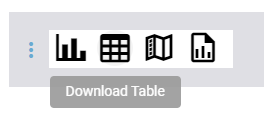
Tutorial
Energy consumption dashboard
This tutorial will provide a step by step description of the construction of a dashboard to analyse and display data on Energy Consumption in Europe. The steps of the example dashboard are available as notebooks inside the examples/EnergyConsumption subfolder. The data for this example has been downloaded from EUROSTAT web site, in particular:
File ten00124_linear.csv: Energy consumption data

Fig. 4 Input data for energy consumption in european countries
File tps00001_tabular.tsv: Population data

Fig. 5 Input data for the population of european countries
Dashboard steps
Scope of the example dashboard on “Energy Consumption in Europe” is to demonstrate a real example of a dashboard built using the vois library.
The dashboard loads the input data from CSV files stored in the same folder of the notebooks using Pandas and displays it in four modes: a chart, a table, a static map and a dynamic map. By “static map” it is meant that a drawing representing a map is displayed, without the possibility to do pan or zoom operations. This display mode is obtained using an SVG drawing. On the contrary, the “dynamic map” is based on a mapping widget that allows users to pan, zoom and click on the geographic features.
Some widgets are added in the various steps to select countries and/or energy sectors and update the views accordingly.
The dashboard is created in 10 (+1) steps, here listed:
Step |
Description |
Link to dashboard |
Source code |
|---|---|---|---|
1 |
Creation of the dashboard structure using the |
||
2 |
Use Pandas to read the input CSVs and display the DataFrame as a table |
||
3 |
Add the filtering controls to the dashboard to select countries and sector |
||
4 |
Add the Plotly Bar Chart View |
||
5 |
Add the SVG Static Map View |
||
6 |
Add the Dynamic Map View |
||
7 |
Add the functions for downloading chart, table and map |
||
8 |
Manage the parameters passsed in the URL and open external URLs |
||
9 |
Add an interactive AnimatedPieChart in SVG to select the consumption sector |
||
Final |
Add minipanel to footer bar and function to generate and download report in docx format |
||
Final dark |
A “dark” version of the final dashboard |

Step 1: Creation of the dashboard structure
The initial step of the dashboard creates the graphical structure of the application using the app.app class.
The first cell contains the customization of the settings that influence the appearance of all the graphical widgets. Here the dark_mode flag is set to False and the main colors of the widgets are defined (settings.color_first and settings.color_second), by selecting two shades of blue/cyan. Then the flag that defines if the button shape is round is set to False (so the buttons will have a ‘squared’ shape in this dashboard). See settings for reference:
from vois.vuetify import settings
settings.dark_mode = False
settings.color_first = '#68aad2'
settings.color_second = '#d8e7f5'
settings.button_rounded = False
Then the import of the libraries used in this version of the dashboard (ipywidgets and ipyvuetify):
from ipywidgets import widgets, Layout, HTML
from IPython.display import display
import ipyvuetify as v
Followed by the import of the app module of the vois library:
from vois.vuetify import app
Ths second cell creates a global variable called g_app containing an instance of the app.app class. All the aspect of the app appearance are defined in the call to app.app(): Title of the dashboard, list of tabs to display in the title bar, credits to show on the right of the title bar, content of the side panel and of the footer bar. To have a list of all the parameters, please consult the page on the app.app.
Four callback functions are defined that simply display a snackbar message to the user when one of the buttons of the app interface is clicked (see snackbar.snackbar module). This messages by default remain visible for 10 seconds and then automatically disappear. The user can click on the ‘Close’ button of the snackbar to close it before the 10 seconds timeout:
# Click on a tab of the title
def on_click_tab(arg):
g_app.snackbar(arg)
# Click on the credits text
def on_click_credits():
g_app.snackbar('Credits')
# Click on the logo
def on_click_logo():
g_app.snackbar('LOGO')
# Click on the footer buttons
def on_click_footer(arg):
g_app.snackbar(arg)
g_app = app.app(title='Energy consumption example dashboard',
titlecredits='Created by Unit I.3',
titlewidth='60%',
footercolor='#dfdfe4',
footercredits='Data',
footercreditstooltip='Eurostat - European Commission',
footercreditsurl='https://ec.europa.eu/eurostat/data/database',
titletabs=['Chart', 'Table', 'Static Map', 'Dynamic Map'],
titletabsstile='font-weight: 700; font-size: 17px;',
dark=False,
backgroundimageurl='https://picsum.photos/id/293/1920/1080',
sidepaneltitle='Help',
sidepaneltext="Lorem ipsum dolor sit amet, consectetur adipiscing elit, sed do eiusmod tempor incididunt ut labore et dolore magna aliqua. Ut enim ad minim veniam, quis nostrud exercitation ullamco laboris nisi ut aliquip ex ea commodo consequat. Duis aute irure dolor in reprehenderit in voluptate velit esse cillum dolore eu fugiat nulla pariatur. Excepteur sint occaecat cupidatat non proident, sunt in culpa qui officia deserunt mollit anim id est laborum.",
sidepanelcontent=[v.Icon(class_='pa-0 ma-0 ml-2', children=['mdi-help'])],
onclicktab=on_click_tab,
onclickcredits=on_click_credits,
onclicklogo=on_click_logo,
onclickfooter=on_click_footer)
g_app.show()
After the two cells are executed, this is the appearance of the dashboard:

Fig. 6 Appearance of the dashboard on step 1
The title bar and the footer bar are displayed, while the central part of the dashboard is empty. In the following steps this part will be filled with visualisations of the input datasets and widgets controls to allow for selections and filtering of input data.
The side panel of the application is already working: it can be opened by clicking on the top-left icon in the title bar.
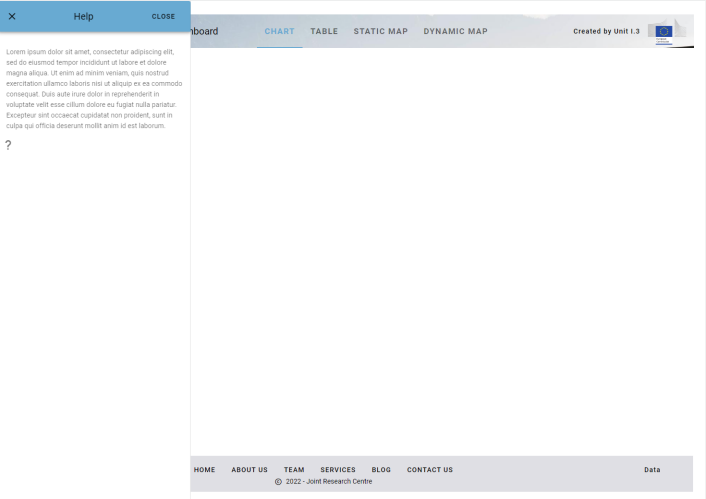
Fig. 7 Opening the sidePanel to show Help content
The button ‘Data’ displayed in the bottom-right corner of the footer bar is working and opens the EUROSTAT web page in another tab of the browser.

Step 2: Use Pandas to read the input CSVs and display the DataFrame as a table
The second step uses the Pandas library to read the input CSVs and display the DataFrame as a table.
In the first cell, the import of the Pandas library is added:
import pandas as pd
Followed by the import of the datatable module of the vois library:
from vois.vuetify import app, datatable
Then the import of the local module EnergyConsumption.py is added. This module contains the python code for loading the input data:
import EnergyConsumption
Here is the code code of the EnergyConsumption.py module:
# Loads input data and returns a pandas dataframe
def loadData():
# Load energy data
df = pd.read_csv('./ten00124_linear.csv')
# Remove columns that are not useful
df.drop(['OBS_FLAG'], axis=1, inplace=True)
# Assign Country to df
df['Country'] = df['geo'].map(code2name)
# Load population data
dfpop = pd.read_csv('./tps00001_tabular.tsv', delimiter='\t')
# Dict key=Code2char value=Population
countrypop = {}
dfpop.rename(columns={'freq,indic_de,geo\TIME_PERIOD': 'geo'}, inplace=True)
columns = dfpop.columns
for index, row in dfpop.iterrows():
geo = row['geo'].split(',')[2]
for col in reversed(columns):
if len(row[col]) > 2:
pop = int(row[col].split(' ')[0])
if pop > 0:
countrypop[geo] = pop
break
# Assign population to df
df['Population2021'] = df['geo'].map(countrypop)
return df
After reading the two datasets, the loadData function adds a new column named ‘Population2021’ to the Pandas DataFrame by taking the rightmost (i.e. more recent) column for each country that contains valid data. In order to purge unnecessary data, some of the columns of the input dataset that contain not useful data (like the ‘siec’ and the ‘unit’ columns) could be removed from the Pandas DataFrame. The DataFrame returned by the call to the EnergyConsumption.loadData function is used in all the subsequent steps of the example dashboard and is stored in the global variable named g_df:
g_df = EnergyConsumption.loadData()
A third cell is added to the notebook, before the creation of the g_app instance, to display the global dataframe g_df inside the Output content of the app instance (see app.app.outcontent):
def displayDatatable():
g_app.outcontent.clear_output(wait=True)
d = datatable.datatable(data=g_df, height='800px')
with g_app.outcontent:
display(d)
Here the g_app.outcontent is the main Output widget that covers all the empty space between the title bar and the footer bar of the app instance. Please note the usage of the datatable.datatable class to display the Pandas DataFrame as a datatable.
Note
The clear_output method of the ipywidgets.Output class takes an optional parameter named wait of type boolean. If this parameter is set to True, the Output widget is not cleared immediately, but only when other content is displayed in the widget. This allows for smooth transitions among different contents and avoids the effect of ‘flickering’. For additional info, see ipywidgets documentation: Output widgets: leveraging Jupyter’s display system
In the last cell of the notebook, the displayDatatable() function is called, just after the creation of the g_app instance.

Fig. 8 Appearance of the dashboard on step 2

Step 3: Add the filtering controls to the dashboard to select countries and sector
The third step adds the filtering controls to the dashboard to select countries and sector, so that the Pandas DataFrame can be browsed per country and per energy sector.
In the first cell of the notebook, the import of selectMultiple, label and toggle widgets is added:
from vois.vuetify import app, selectMultiple, label, datatable, toggle
A cell is added in second position in the notebook. It contains code to create the ipywidgets.Output widgets that subdivide the space of the dashboard in parts for specific usage:
#border = '1px solid lightgrey'
border = 'none'
# Dimensioning
widthinpx = 260
widthControls = '%dpx' % widthinpx
heightinpx = 830
height = '%dpx' % heightinpx
height_net = '%dpx' % (heightinpx-10)
outControls = widgets.Output(layout=Layout(width=widthControls, min_width=widthControls, height=height, border=border))
outDisplay = widgets.Output(layout=Layout(width='90%', height=height, border=border))
In the code, some dimensioning in width and height is defined (expressed in pixels), and two Output widgets are created. The first is named outControls and will host some widgets to select the country and the energy sector that originates the consumption (industrial, commercial, etc.). The second Output widget is called outDisplay and will contain the visualisation defined by the user acting on the controls.
Interesting to note is the usage of the width in pixels for outControls and the with in percentage for the outDisplay. Combining it with the layout.min_width setting, this allows for having a outControls widget of fixed horizontal dimension of 260 pixels, while the outDisplay will occupy the remaining part of the page, whatever is the total dimension of the screen (fullHD, table, smartphone, etc.).
Also interesting is the first line of the cell where the variable border is defined to be 1 pixel and grey. If this line is uncommented, and the following one is commented, the border of the two Output widgets will become visible and this can be useful during the development of the dashboard or for debugging purpose to check that their dimensions behave correctly. This can be achieved also adding a new cell in the notebook and executing these commands:
outControls.layout.border = '1px solid grey'
outDisplay.layout.border = '1px solid grey'
The cells added in the central part of the notebook will fill the two Output widget with the content. The display of these widgets inside the g_app.outcontent is done by this line added in the last cell of the notebook, just after the creation of the app.app instance:
with g_app.outcontent:
display(widgets.HBox([outControls,outDisplay]))
This code displays the two Output widget using the ipywidgets.HBox method that serves to display two or more widgets side by side in the same horizontal line (see ipywidgets documentation: Container/Layout widgets )
Following the cell that loads the input data, a new cell is added that defines some global variables:
g_countries = [] # Selected countries codes
g_dtfiltered = None # Filtered dataframe
g_currentgeo = '' # list of comma-separated names of the selected countries
g_sector = 'FC_E'
g_units = 'Thousand tonnes of oil equivalent'
g_year = g_df['TIME_PERIOD'].max()
# Ordered list of sectors
g_sectors = ['FC_E', 'FC_IND_E', 'FC_TRA_E', 'FC_OTH_CP_E', 'FC_OTH_HH_E']
# Short names of the sectors
g_sectorTitle = {
'FC_E': 'Total',
'FC_IND_E': 'Industrial',
'FC_TRA_E': 'Transports',
'FC_OTH_CP_E': 'Commercial',
'FC_OTH_HH_E': 'Households',
}
# Long names of the sectors
g_sectorName = {
'FC_E': 'Total energy consumption',
'FC_IND_E': 'Industrial energy consumption',
'FC_TRA_E': 'Transports energy consumption',
'FC_OTH_CP_E': 'Commercial energy consumption',
'FC_OTH_HH_E': 'Households energy consumption',
}
In particular g_sector is a list of the codes of the energy sectors, as they appear in the columns of the input Pandas DataFrame, while g_sectorTitle and g_sectorName are two dictionary to retrieve the short and long name of a sector given its code.
The following cell creates some widgets to filter the input data. A first widget is a selectMultiple.selectMultiple instance to select one or more countries. When no country is selected, the total data for Europe27 will be displayed, while when a valid selection is done, only the rows of the g_df Pandas Dataframe related to the selected countries will be displayed. This widget is created with the following instruction:
selcountry = selectMultiple.selectMultiple('Country:', EnergyConsumption.eunames, width=widthinpx-30,
mapping=countries_mapping, onchange=onchange_country, marginy=2)
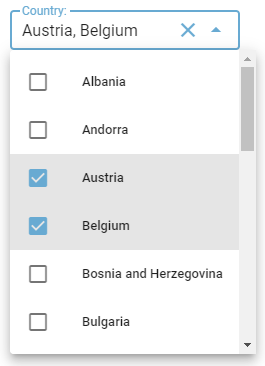
Fig. 9 selectMultiple widget for countries
The values displayed by the selectMultiple widget will be the EUROSTAT Country Names (content of the variable EnergyConsumption.eunames taken from the svgMap module and derived from the EUROSTAT Country Codes) while the mapping with the function countries_mapping will convert the name of the countries to their corresponding codes. If name is None the function returns the code for EU27.
The onchange_country function is called every time the user makes a selection in the country widget and it changes the value of the global variable g_countries to be the list of the codes of the selected countries. Then the UpdateDataframe function is called to update the visualisation:
# Selection of a country
def onchange_country():
global g_countries
g_countries = selcountry.value
UpdateDataframe()
displayDatatable()
A second widget is created as a toggle.toggle instance to display buttons (displayed in vertical mode) for the energy sectors:
selsector = toggle.toggle(0,
[g_sectorTitle[x] for x in g_sectors],
tooltips=[g_sectorName[x] for x in g_sectors],
onchange=onchange_sector,
row=False,
width=widthinpx-30)
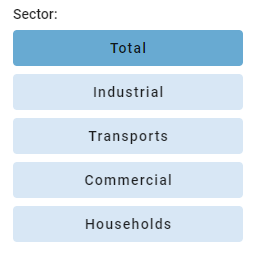
Fig. 10 Toggle widget for sectors
Here the title of the sector is displayed in the buttons, while the full name of the sector is used as tooltip when the user hovers one of the buttons.
The onchange_sector function is called every time the user makes a selection in the sector widget and it changes the value of the global variable g_sector to be the code of the selected sector. Then the UpdateDataframe function is called to update the visualisation:
# Selection of a sector
def onchange_sector(value):
global g_sector
g_sector = g_sectors[value]
UpdateDataframe()
displayDatatable()
The UpdateDataframe is responsible for creating a filtered version of the Pandas DataFrame to contain only the rows corresponding to the user selections in the selectMultiple and toggle widgets:
# Update the filtered dataframe
def UpdateDataframe():
global g_dtfiltered, g_currentgeo
# Filter dataset on country and sector
if len(g_countries) == 0:
codes = ['EU27_2020']
g_currentgeo = 'Europe27'
else:
codes = g_countries
g_currentgeo = ', '.join([EnergyConsumption.code2name[x] for x in g_countries])
g_dtfiltered = g_df[(g_df['geo'].isin(codes))&(g_df['nrg_bal']==g_sector)].copy()
g_dtfiltered.rename({'TIME_PERIOD': 'Year', 'OBS_VALUE': g_units}, axis=1, inplace=True)
This function updates the global variable g_dtfiltered to contain only the rows where the ‘geo’ column contains one of the codes of the selected countries and where the ‘nrg_bal’ column corresponds to the selected energy sector.
Finally, the outControls widget is filled with the controls:
outControls.clear_output()
with outControls:
display(selcountry.draw())
display(labelEmpty.draw())
display(labelSector.draw())
display(selsector.draw())
Since the widget are positioned in vertical one after the other, 4 simple calls to the display method are used. As an altenative one could have used the ipywidgets.VBox layout widget to get the same result. Please note the usage of the draw() method which is the method that all the widgets of the vois library implement to return a real instance of the underlining ipyvuetify widget to be displayed.
This is the apperance of the dashboard after the execution of the Step 3 notebook cells:

Fig. 11 Appearance of the dashboard on step 3

Step 4: Add the Plotly Bar Chart View
The 4th step adds the Plotly Bar Chart View to the dashboard.
In the first cell of the notebook, the import of the plotly library is added:
import plotly.express as px
import plotly.graph_objects as go
Here px is the Plotly Express version of the Plotly API, while go is the Plotly Graph Objects API. Both versions of the library are used in this example.
In the cell containing the global variables, a new variable is added, storing the color sequence selected from those available in the Plotly library (see Discrete Color Sequences in Plotly Express and Built-In Sequential Color scales):
# Color sequence to use in the Plotly chart
g_colorsequence = px.colors.sequential.Blues[::-1]
A new cell is added to the notebook to define the python function responsible for the update of the outDisplay Output widget with a Plotly Bar chart:
def displayChart():
global g_last_fig
outDisplay.clear_output(wait=False)
with outDisplay:
title = g_sectorName[g_sector] + ' for ' + g_currentgeo
if len(g_countries) <= 1:
g_last_fig = px.bar(g_dtfiltered, x='Year', y=g_units, color="Country", template='plotly_white', text_auto=True, color_discrete_sequence=g_colorsequence)
g_last_fig.update_xaxes(tickvals=g_dtfiltered['Year'])
else:
g_last_fig = go.Figure()
i = 0
allyears = set()
for code in g_countries:
dfsel = g_dtfiltered[g_dtfiltered['geo']==code]
years = dfsel['Year'].unique()
allyears.update(years)
g_last_fig.add_trace(go.Bar(x=years, y=dfsel[g_units], name=EnergyConsumption.code2name[code], textposition="inside", texttemplate="%{y}", marker_color=g_colorsequence[i]))
i += 1
i = i % len(g_colorsequence)
g_last_fig.update_layout(barmode='group', template='plotly_white', legend_title='Country', xaxis_title="Year", yaxis_title="Thousand tonnes of oil equivalent")
g_last_fig.update_xaxes(tickvals=sorted(list(allyears)))
g_last_fig.update_layout(height=heightinpx-10, margin=dict(t=84, l=0, r=0, b=0), title={'text': title})
g_last_fig.show(config={'displaylogo': False, 'displayModeBar': False})
The displayChart function updates the outDisplay Output widget by clearing its content and replacing it with a Plotly Figure object. In case a single country is currently selected or no countries are selected, the chart is created using the px.bar interface, while in case two or more countries are selected, the Figure is created by adding one trace for each country. Each of the traces are created using the go.bar interface. The Figure is stored in the global variable g_last_fig to be used in the next steps for the download operations.
In this step of the dashboard the tabs that are present in the title bar are managed. In particular, the on_click_tab function is now modified to manage the display of the ‘Chart’ or ‘Table’ view of the filtered dataset:
# Click on a tab of the title: change the current view
def on_click_tab(arg):
global g_view
if arg == 'Chart':
g_view = 0
elif arg == 'Table':
g_view = 1
else:
g_app.snackbar(arg)
displayCurrentView()
This function sets the global variable g_view to the correct value (0=Chart, 1=Table, 2=Static Map, 3=Dynamic Map) and calls the displayCurrentView function that is responsible for deciding which display function to call:
# Display the current view in the outDisplay
def displayCurrentView():
if g_view == 0:
displayChart()
elif g_view == 1:
displayDatatable()
elif g_view == 2:
pass
else:
pass
At this stage the dashboard looks like:

Fig. 12 Appearance of the dashboard on step 4

Step 5: Add the SVG Static Map View
This step adds the SVG Static Map View to the dashboard. This type of map represents the countries of Europe as a drawing, without any possibility of doing pan or zoom operations.
In the first cell the list of modules imported from the vois library is updated:
from vois.vuetify import app, selectMultiple, label, datatable, toggle,
tooltip, slider, switch
from vois import svgMap
Two new Output widgets are created. They will partition the outDisplay Output in a left part containing controls to customize the Map views, and a right part to display the Map view itself:
outMapControls = widgets.Output(layout=Layout(width=widthControls, min_width=widthControls,
height=height_net, border=border))
outMap = widgets.Output(layout=Layout(width='90%', height=height_net, border=border))
Then the controls are created:
labelYear = label.label('Select the Year:', textweight=400, height=26, margins=3, margintop=0)
sliderYear = slider.slider(g_year, g_minyear,g_maxyear, onchange=onchange_year)
popswitch = switch.switch(g_usepop, "Normalize by Population", onchange=on_popswitch_change)
The slider.slider instance will enable the user to select the year to be displayed on the map, and the switch.switch instance is meant to enable the display of data normalized by the population of the respective country (i.e. energy consumption per 100K inhabitants).
When the user changes one of these settings, these two functions are called to update the Map view:
# Selection of a year
def onchange_year(value):
global g_year
g_year = value
UpdateDataframe()
displayCurrentView()
# Switch among total values or values normalized by population
def on_popswitch_change(arg):
global g_usepop
g_usepop = not g_usepop
UpdateDataframe()
displayCurrentView()
The functions displayCurrentView and on_click_tab are updated to manage the selection of the ‘Static Map’ tab in the title bar:
def displayCurrentView():
if g_view == 0:
displayChart()
elif g_view == 1:
displayDatatable()
elif g_view == 2:
displayStaticMap()
else:
pass
...
g_maintabs = ['Chart', 'Table', 'Static Map', 'Dynamic Map']
# Click on a tab of the title: change the current view
def on_click_tab(arg):
global g_view
if arg == g_maintabs[0]:
g_view = 0
elif arg == g_maintabs[1]:
g_view = 1
elif arg == g_maintabs[2]:
displayMapControls()
g_view = 2
else:
displayMapControls()
g_view = 3
displayCurrentView()
A new global variable named g_maintabs is added to store the names of the 4 tabs in the Title Bar so that those strings are written in a single place and their management becomes easier in case of changes.
The displayStaticMap function is a new function to update the Map Output with a static map of Europe. It is created by deriving a dfmap Pandas Dataframe where the ‘value’ column is the total consumption or the consumption per 100K inhabitants, depending on the curren status of the population switch. The map is calculated using the svgMap.svgMapEurope() that returns a string in SVG (see SVG: Scalable Vector Graphics). This string is displayed using call to display(HTML()):
def displayStaticMap():
global g_last_svg
# Prepare the pandas dataframe
dfmap = g_df[(g_df['TIME_PERIOD']==int(g_year))&(g_df['nrg_bal']==g_sector)].copy()
dfmap = dfmap[dfmap['geo'].isin(svgMap.country_codes)]
if g_usepop:
dfmap['value'] = 100000.0 * dfmap['OBS_VALUE'] / dfmap['Population2021']
legendunits = 'KTOE per 100K inhabit.'
else:
dfmap['value'] = dfmap['OBS_VALUE']
legendunits = g_units
colorlist = g_colorsequence[::-1] # From lighter to darkest!
# Display the map
outMap.clear_output(wait=True)
with outMap:
selected = []
if g_countries == ['EU27_2020']: selected = []
else: selected = g_countries
g_last_svg = svgMap.svgMapEurope(dfmap, code_column='geo', value_column='value', codes_selected=selected, stroke_selected='red',
colorlist=colorlist, stdevnumber=2.0,
onhoverfill='#f8bd1a', width=1480-2*widthinpx, stroke_width=3.0, hoveronempty=False,
legendtitle=str(g_year) + ' ' + g_sectorName[g_sector], legendunits=legendunits)
display(HTML(g_last_svg))
In the call to svgMap.svgMapEurope() function, the column named geo of the dfmap DataFrame is used to match the corresponding polygon using the EUROSTAT Country Codes, and the related numerical value taken from the value column is assigned to the polygon. With all the polygons having their values assigned, the mean and standard deviation of all the values are calculated, and the range of values [mean - 2*stddev, mean + 2*stddev] is linearly assigned to the input colorlist (the Plotly px.colors.sequential.Blues).
The codes of the countries selected in the selectMultiple object are passed to the svgMapEurope function to highlight in red the border of the countries on the map drawing and on the legend.
This is the apperance of the dashboard after the execution of the Step 5 notebook cells:

Fig. 13 Appearance of the dashboard on step 5

Step 6: Add the Dynamic Map View
This step adds the Dynamic Map View to the dashboard. The Map is created using the ipyleaflet widget library which is a porting into the Jupyter world of the widely used Leaflet JS library. Maps created in this way allow the users to do panning and zooming operation and to click on the features displayed in the map to get information. Vois library has a leafletMap module that exports some functions for adding custom vector dataset to a ipyleaflet interactive map.
In the first cell of the notebook, some additional import commands are added:
from ipyleaflet import basemaps
from vois import svgMap, leafletMap, svgUtils, geojsonUtils
The basemaps module allows for the selection of a backdrop dataset to be displayed in a ipyleaflet map, while the modules leafletMap and geojsonUtils are used for importing a geospatial dataset in geojson format inside the map and svgUtils is used to display a graduated legend that helps in understanding the colors assigned to the country polygons.
The same Pandas DataFrame calculated in the previous step as input to the Static Map is used to define the colors to be assigned to the polygons of the Dynamic Map. For this reason some lines of code that in the previous step were written inside the displayStaticMap function, are now extrapolated and inserted in a new function that returns the DataFrame used by both the Static and the Dynamic Map:
# Prepare the pandas dataframe for the Map display (returns a df)
def dataframeForMap():
dfmap = g_df[(g_df['TIME_PERIOD']==int(g_year))&(g_df['nrg_bal']==g_sector)].copy()
dfmap = dfmap[dfmap['geo'].isin(svgMap.country_codes)]
if g_usepop:
dfmap['value'] = 100000.0 * dfmap['OBS_VALUE'] / dfmap['Population2021']
else:
dfmap['value'] = dfmap['OBS_VALUE']
return dfmap
The important addition of this step of the dashboard is the displayDynamicMap function. Its main content is the creation of the Dynamic Map starting from the dfmap returned by the dataframeForMap function call and a geojson file named ne_50m_admin_0_countries.geojson that is stored under the data folder:
g_map = leafletMap.geojsonMap(dfmap,
'./data/ne_50m_admin_0_countries.geojson',
'ISO_A2_EH',
code_column='geo',
value_column='value',
codes_selected=selected,
stroke_selected='red',
colorlist=colorlist,
stdevnumber=2.0,
stroke_width=0.6,
stroke='#010101',
width='70%',
height=height,
center=g_center,
zoom=g_zoom,
basemap=basemaps.Esri.WorldTopoMap,
style ={'opacity': 1, 'dashArray': '0', 'fillOpacity': 0.85},
hover_style={'opacity': 1, 'dashArray': '0', 'fillOpacity': 0.99})
The ne_50m_admin_0_countries.geojson file was obtained from the Natural Earth web site and contains polygons for all the countries of the world. Unfortunately, this dataset uses a different coding for the countries: instead of the EUROSTAT Country Codes, it uses the ISO 3166 standard in the attribute named ‘ISO_A2_EH’. The only practical consequence of having two sets of codes is that we have to cope with the two different codes that are assigned to Greece, which is coded EL in the EUROSTAT Country Code and GR in the ISO 3166 standard. This is managed by these two lines:
dfmap['geo'].replace('EL','GR',inplace=True)
selected = ['GR' if x=='EL' else x for x in selected]
These two lines substitute all occurrencies of ‘EL’ with ‘GR’ before calling the leafletMap.geojsonMap function.
These lines are added to observe any zoom and panning event in the dynamic map:
g_map.observe(map_on_bounds_changed, names='bounds')
The map_on_bounds_changed is called any time that the map bounds (the east/west/south/north coordinates) are changed by a user action. Its code stores the center and the zoom level into two global variables g_center and g_zoom:
# Store center and zoom at each zoom or panning of the user
def map_on_bounds_changed(args):
global g_center, g_zoom
if not g_map is None:
g_center = g_map.center
g_zoom = g_map.zoom
These values are then used any time that the Dynamic Map is updated (for instance when the user selects a different year) to recreate the new map with the same visible portion of the globe on the screen.
In the call to leafletMap.geojsonMap() function, the column named geo of the dfmap DataFrame is used to match the corresponding polygon using the ISO 3166 standard, and the related numerical value taken from the value column is assigned to the polygon. With all the polygons having their values assigned, the mean and standard deviation of all the values are calculated, and the range of values [mean - 2*stddev, mean + 2*stddev] is linearly assigned to the input colorlist (the Plotly px.colors.sequential.Blues). A call to the svgUtils.graduatedLegend() is then used to create a graduated colors legend in SVG format to be displayed on the right side of the map:
svg = svgUtils.graduatedLegend(dfmap, code_column='geo', value_column='value',
codes_selected=selected, stroke_selected='red',
colorlist=colorlist, stdevnumber=2.0,
legendtitle=str(g_year) + ' ' + g_sectorName[g_sector],
legendunits=legendForUnits(),
fontsize=15, width=340, height=heightinpx-60)
This is the part of the new code that clears the outMap Output widget and then displays in it both the ipyleaflet Map and the SVG graduated color legend:
# Display the legend
outlegend = widgets.Output(layout=Layout(width='360px',height=height))
with outlegend:
display(HTML(svg))
# Display the map
outMap.clear_output(wait=True)
with outMap:
display(widgets.HBox([g_map,outlegend]))
The functions displayCurrentView and on_click_tab are updated to manage the selection of the ‘Dynamic Map’ tab in the title bar:
def displayCurrentView():
if g_view == 0:
displayChart()
elif g_view == 1:
displayDatatable()
elif g_view == 2:
displayStaticMap()
elif g_view == 3:
displayDynamicMap()
...
g_maintabs = ['Chart', 'Table', 'Static Map', 'Dynamic Map']
# Click on a tab of the title: change the current view
def on_click_tab(arg):
global g_view, g_center, g_zoom
if arg == g_maintabs[0]:
g_view = 0
elif arg == g_maintabs[1]:
g_view = 1
elif arg == g_maintabs[2]:
displayMapControls()
g_view = 2
else:
g_center = [56,11]
g_zoom = 4
displayMapControls()
g_view = 3
displayCurrentView()
This is the apperance of the dashboard after the execution of the Step 6 notebook cells:

Fig. 14 Appearance of the dashboard on step 6

Step 7: Add the functions for downloading chart, table and map
The 7th step adds the functions for downloading chart, table and map view.
The first cell of the notebook has some new import instructions:
from datetime import datetime
import io
from cairosvg import svg2png
These new lines import modules used by the export code (svg2png is a module of the cairosvg package that converts SVG drawings to raster PNG format). From the vois library, the module fab is imported:
from vois.vuetify import app, selectMultiple, label, datatable,
toggle, tooltip, slider, switch, fab
fab is a module of the vois library that helps in creating Floating-Action-Button, i.e. buttons that are positioned in absolute mode on the page and that display a menu when hovered.
In the last cell of the notebook, just after the creation of the g_app instance, the download fab button is created:
b = g_app.fab(left='96%', top='108px',
items=['Download Chart', 'Download Table', 'Download Map'],
onclick=[ondownloadCHART,ondownloadCSV,ondownloadMAP])
This button is positioned in the topright portion of the screen and, when hovered, it shows three menu items for downloading the chart, the table and the map view.
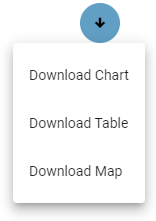
Fig. 15 Download functions in the fab button
The corresponding download functions are declared in a new cell that contains these lines for the download of the Poltly chart:
# Download Chart in PNG
def ondownloadCHART():
global g_view
if g_view != 0:
g_view = 0
g_app.setActiveTab(g_view)
on_click_tab(g_maintabs[g_view])
if not g_last_fig is None:
filename = 'Energy_' + datetime.today().strftime('%Y-%m-%d_%H-%M-%S')
png = g_last_fig.to_image(format="png", width=1800)
buf = io.BytesIO(png)
buf.seek(0)
barray = buf.read()
#with open("chart.png", "wb") as file:
# file.write(barray)
g_app.downloadBytes(barray,'%s.png' % filename)
These are the lines for the download of the tabular data in CSV format:
# Download data in CSV format
def ondownloadCSV():
if not g_dtfiltered is None:
filename = 'Energy_' + datetime.today().strftime('%Y-%m-%d_%H-%M-%S')
df = g_dtfiltered.copy()
df = df.reset_index(drop=True)
buf = io.StringIO()
df.to_csv(buf)
buf.seek(0)
text = buf.getvalue()
g_app.downloadText(text,"%s.csv" % filename)
These are the lines to download the static map in PNG format:
# Download Map in PNG
def ondownloadMAP():
global g_view
g_app.dialogWaitOpen(text='Please wait for Map export...')
if g_view != 2:
g_view = 2
g_app.setActiveTab(g_view)
on_click_tab(g_maintabs[g_view])
if not g_last_svg is None:
filename = 'Energy_' + datetime.today().strftime('%Y-%m-%d_%H-%M-%S')
svg_picture = g_last_svg
svg_picture = svg_picture.replace(' ','&nbsp;')
svg_picture = svg_picture.replace('style="font-family: Roboto;"','')
png = svg2png(bytestring=svg_picture, parent_width=1850, parent_height=600)
buf = io.BytesIO(png)
buf.seek(0)
barray = buf.read()
#with open("map.png", "wb") as file:
# file.write(barray)
g_app.downloadBytes(barray,'%s.png' % filename)
g_app.dialogWaitClose()
All the three download functions use the g_app methods app.app.downloadText() and app.app.downloadBytes() to download textual and binary files to the user local machine. The download of the Static Map, given that the download operations can take some seconds, is enclosed in the opening and closing of a dialogWait.dialogWait invoked through the g_app instance:
g_app.dialogWaitOpen(text='Please wait for Map export...')
...
g_app.dialogWaitClose()

Fig. 16 Dialog-box displayed during the preparation of the data for the download of the Map

Step 8: Manage the parameters passed in the URL and open external URLs
This step adds the management of the parameters passsed in the URL and adds the opening of an external URLs when the user clicks on the EC logo in the title bar.
In developing real dashboards, there can be the need to manage the parameters passed in the URL that launched the application. It can be useful, for instance, to have a dashboard that provides different views of the same data, that are invoked by passing a parameter in the URL (for instance adding “?view=1” or “?view=2” to the URL). The python code of the dashboard can read these parameters and behave accordingly.
In order to add this new functionality, only the last cell of the notebook is modified in this 8th step. These lines of code are added just after the creation of the g_app and the fab button:
# Read the URL parameters
g_view = int( g_app.urlParameter('view', g_view))
g_sector = str( g_app.urlParameter('sector', g_sector))
g_year = int( g_app.urlParameter('year', g_year))
g_usepop = bool(g_app.urlParameter('usepop', g_usepop))
countries = str( g_app.urlParameter('countries', ''))
if len(countries) <= 0: g_countries = []
else: g_countries = countries.split(',')
The function app.app.urlParameter() is called five times to read one URL parameter given its name. The values read from the URL are assigned to the global variables g_view, g_sector, g_year, g_usepop and g_countries. These global variables are used to set the active tab in the title bar of the g_app and to change the current value of the input widgets:
g_app.setActiveTab(g_view)
on_click_tab(g_maintabs[g_view])
if g_sector in g_sectors:
selsector.value = g_sectors.index(g_sector)
sliderYear.value = g_year
popswitch.value = g_usepop
selcountry.value = g_countries
The call to:
UpdateDataframe()
displayCurrentView()
updates the content displayed in the Output widgets according to the parameters passed in the URL.
To fully manage the URL parameters, it is also useful to update the URL in the browser address bar when the user operates on the widgets of the dashboard (it is a function similar to what is implemented by web sites like https://www.google.com/maps/: panning and zooming on the map updates the address bar of the browser by adding the center position and the zoom level of the map). This can be obtained by calling the helper function urlUpdate() to pass the part of the URL to modify after the ‘?’, as in the urlUpdate function:
# Update the URL
def urlUpdate():
url = "?view=%d&countries=%s§or=%s&year=%d&usepop=%d" % (int(g_view),
",".join(g_countries),
str(g_sector),
int(g_year),
int(g_usepop))
g_app.urlUpdate(url)
The urlUpdate function is then called in all the functions that are executed when the user operates a selection on the widgets control, like in the functions onchange_country, onchange_sector, onchange_year, on_popswitch_change and on_click_tab. In this way the URL displayed while the dashboard is active, always reflects the current status and can be, for instance copy/pasted to return to the same situation at a later stage or pass the complete URL to a colleague.
Finally, in the python function that manages the click on the logo, the call to open an external page is added, instead of simply send a snackbar message to the user, by using the app.app.urlOpen() method of the app.app class:
# Click on the logo
def on_click_logo():
g_app.urlOpen('https://ec.europa.eu/info/index_en')

Step 9: Add an interactive AnimatedPieChart in SVG to select the consumption sector
The 9th step of the Energy Consumption dashboard adds an interactive AnimatedPieChart in SVG to select the consumption sector. The contribution of this addition is not important for the new functionality that it provides to the user, but as an example of an interactive SVG drawing inside the dashboard. The SVG added is ‘interactive’ in the sense that it is not only a drawing with an animation, but it manages user actions like click events, to provide some functionality to the application. This function is based on small but very important component called ipyevents, that is able to capture events occurring in the user client browser (like the user clicking on a slice of the pie), and pass it back to the python kernel to execute a function when it happens. This allows dashboard developers to complement their applications with reactive custom drawing that can fill the gaps of the standard charting libraries like Plotly or Bokeh: when a chart that is requested is not available in those libraries, an interactive SVG drawing can be added to the dashboard.
Here is a picture of the animated pie chart that is added in this step.

Fig. 17 The animated pie chart added to the dashboard
The chart graphically represents the subdivision of the energy consumptions for the current countries selection in the different sectors (transport, commercial, etc.). By clicking in one of the pie slices, the corresponding sector is selected (similarly to the clicking on the buttons of the sectors toggle widget)
Let’s examine the code added to the notebook to obtain the new function. First of all, a new Output widget named outAnimation is created in the second cell of the notebbook and the Output widgets dimensioning for the Map and the Map controls are slightly modified:
widthmapinpx = 360
widthMapControls = '%dpx' % widthmapinpx
outMapControls = widgets.Output(layout=Layout(width=widthMapControls, min_width=widthMapControls, height=height_net, border=border))
outMap = widgets.Output(layout=Layout(width='90%', height=height_net, border=border))
widthanimpx = widthmapinpx - 20
widthanim = '%dpx' % (widthanimpx+10)
outAnimation = widgets.Output(layout=Layout(width=widthanim, min_width=widthanim, height=widthanim, border=border))
Then, a new cell is added containing the code to create and display the animated pie chart:
# Display Pie Chart animation
def displayAnimation():
outAnimation.clear_output(wait=True)
if len(g_countries) == 0: codes = ['EU27_2020']
else: codes = g_countries
df_country_year = g_df[(g_df['geo'].isin(codes))&(g_df['TIME_PERIOD']==g_year)]
df_country_year = df_country_year.groupby(["nrg_bal"])["OBS_VALUE"].sum().to_frame().reset_index()
sectors = list(df_country_year['nrg_bal'])
values = list(df_country_year['OBS_VALUE'])
chartvalues = []
chartlabels = []
chartsectors = []
if 'FC_E' in sectors:
totalindex = sectors.index('FC_E')
totalvalue = values[totalindex]
total = 0.0
for s,v in zip(sectors,values):
if s != 'FC_E':
total += v
chartvalues.append(round(v,2))
chartlabels.append(g_sectorTitle[s])
chartsectors.append(s)
chartvalues.append(round(totalvalue - total,2))
chartlabels.append('Other')
chartsectors.append(None)
def onclick(arg):
newsector = chartsectors[arg]
if not newsector is None:
g_sector = newsector
selsector.value = g_sectors.index(g_sector)
out, txt = svgUtils.AnimatedPieChart(values=chartvalues, labels=chartlabels, decimals=1,
centerfontsize=28, fontsize=16, textweight=500, colors=px.colors.sequential.Blues, backcolor='#e0e0e0',
centertext='Sector', onclick=onclick, dimension=widthanimpx-15, duration=1.0)
with outAnimation:
display(out)
The first lines of the displayAnimation new function extract the information on sector consumptions from the current Pandas DataFrame g_df, to create a list of sector names (chartlabels) and a corresponding list of numerical values (chartvalues). Then the svgUtils.AnimatedPieChart() method is called passing these two lists as input data for the creation of the pie chart. A local pyton function is also passed as the onclick parameter. This function will be called (thanks to the internal code of the svgUtils.AnimatedPieChart() method that uses ipyevents to capture the events) at each click on the slices of the pie chart. The onclick function will receive as parameter the label of the clicked slice and this allows the function to update the value of the selsector toggle widget.
Note
Please note that, given that the svgUtils.AnimatedPieChart() method is meant to capture users events, it returns an Output widget instance. This Output widget is created internally and is passed to the ipyevents events manager to capture user clicks. For those interested in understanding how this works, pleas refer to the source code of the svgUtils.AnimatedPieChart() method, and in particular these lines:
d = Event(source=out, watched_events=['click'])
def handle_event(event):
...
d.on_dom_event(handle_event)

Step 10 dark: Creation of the “dark” version of the final dashboard
It can be useful to be able to create Voilà dashboard that use the “Dark Theme”. To obtain a “dark” dashboard, some additional steps have to be performed. First of all, the Step 10 example notebook EnergyConsumption.Final.ipynb has been copied to another notebook and named EnergyConsumption.Final.ThemeDark.ipynb. The first action to convert the dashboard to the “Dark Theme” is to edit the .ipynb file using the text editor and add this settings to the “metadata” part of the notebook JSON:
,
"voila": {
"theme": "dark"
}
as shown in this screenshot:
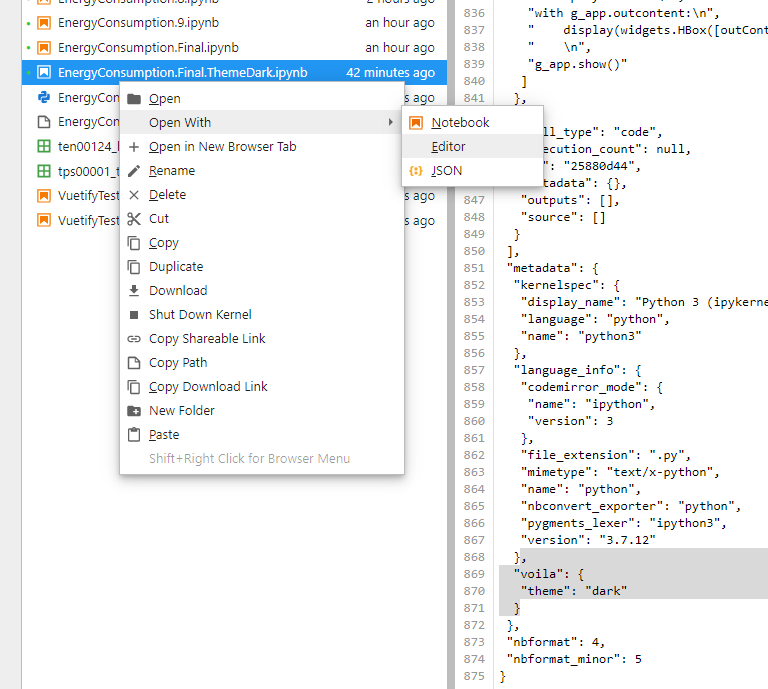
Fig. 19 Open in editor the source JSON notebook and add the “voila” “theme” “dark” setting.
Then the first cell of the notebook is modified by adding the global variable g_dark with value True and changing settings.dark_mode to True. The first and second color are also changed, as well as the background color of the tooltips (see settings):
g_dark = True
from vois.vuetify import settings
settings.dark_mode = g_dark
settings.color_first = '#68aad2'
settings.color_second = '#1c4056'
settings.button_rounded = False
settings.tooltip_backcolor = '#424242'
Then, immediately after the import of the ipyvuetify package, the dark_mode is selected for the widgets of that library:
# Set the dark theme for ipyvuetify!!!
import ipyvuetify as v
v.theme.dark = g_dark
The calls to svgUtils.svgMapEurope() and to svgUtils.graduatedLegend() need to have the dark parameter set to True, so that the border of the countries and the legends are displayed converting ‘black’ to ‘white’. The same is done in the call to create the g_app instance of the app.app class, to draw as white the texts of the title bar and of the footer bar:
dark=g_dark,
footerdark=g_dark,
The template=’plotly_dark’ parameter is added to the methods called from the Plotly library inside the displayChart function to select the dark theme.
Then the backcolor of the call to svgUtils.AnimatedPieChart() in the displayAnimation function is changed, as well as the basemap for the Dynamic Map that is changed to basemaps.CartoDB.DarkMatter.
Here is the final dashboard changed to use the dark theme:

Fig. 20 Dark version of the final dashboard
MultiPage Demo
New classes added to the vois library allow for easy creation of multi-pages applications: mainPage.mainPage class and page.page class.
The mainPage class creates a fullscreen page displaying a background image, a title/subtitle/logo and some buttons. Each button on the mainPage can open a specific page.
A minimal example of a multi-page application can be created by running this example code:
from vois.vuetify import mainPage, page
from random import randrange
from ipywidgets import widgets, Layout
output = widgets.Output(layout=Layout(width='0px', height='0px'))
display(output)
title = 'MultiPage Demo'
logo = 'https://jeodpp.jrc.ec.europa.eu/services/shared/pngs/BDAP_Logo1024transparent.png'
copyright = 'European Commission - Joint Research Centre'
def randomPicture():
return 'https://picsum.photos/seed/%d/200/200'%randrange(1000)
def onclick1():
p = page.page(title, 'Function 1', output, titlecolor='#808dc4', titledark=True,
footercolor='#cccccc', logoappurl=logo, copyrighttext=copyright)
card = p.create()
card.children = ['Put widgets into the empty space of the page1']
p.open()
def onclick2():
p = page.page(title, 'Function 2', output, titlecolor='#808dc4', titledark=True,
footercolor='#cccccc', logoappurl=logo, copyrighttext=copyright)
card = p.create()
card.children = ['Put widgets into the empty space of the page2']
p.open()
m = mainPage.mainPage(title='MultiPage Demo',
subtitle='Showcase how easy is to create a multi-page app',
credits="vois library development team",
titlebox_widthpercent=50, titlebox_opacity=0.2, titlebox_border=0,
vois_show=True, vois_opacity=0.1,
button_widthpercent=23, button_heightpercent=14,button_elevation=16, button_opacity=0.6,
background_image=55,
background_filter='blur(2px) brightness(1.2) contrast(0.7) sepia(0.05) saturate(1.2)',
creditbox_opacity=0,
text_color='#222222')
m.addButton('Function 1', tooltip='Tooltip text to display on hover function1',
image=randomPicture(), onclick=onclick1)
m.addButton('Function 2', tooltip='Tooltip text to display on hover function2',
image=randomPicture(), onclick=onclick2)
for i in range(3,7): m.addButton('Function %d'%i, image=randomPicture())
m.open()
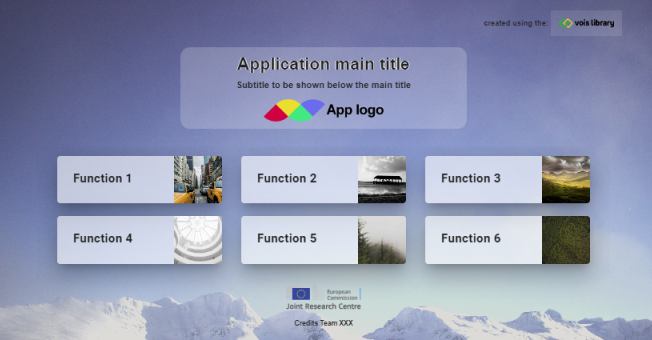
Fig. 21 Example of a mainPage
The vois library provides sixty wallpapers that can be used as backgrounds to the mainPage of an application, by simply passing an integer value in the range [0,59] to the background_image parameter of the mainPage initialization function.
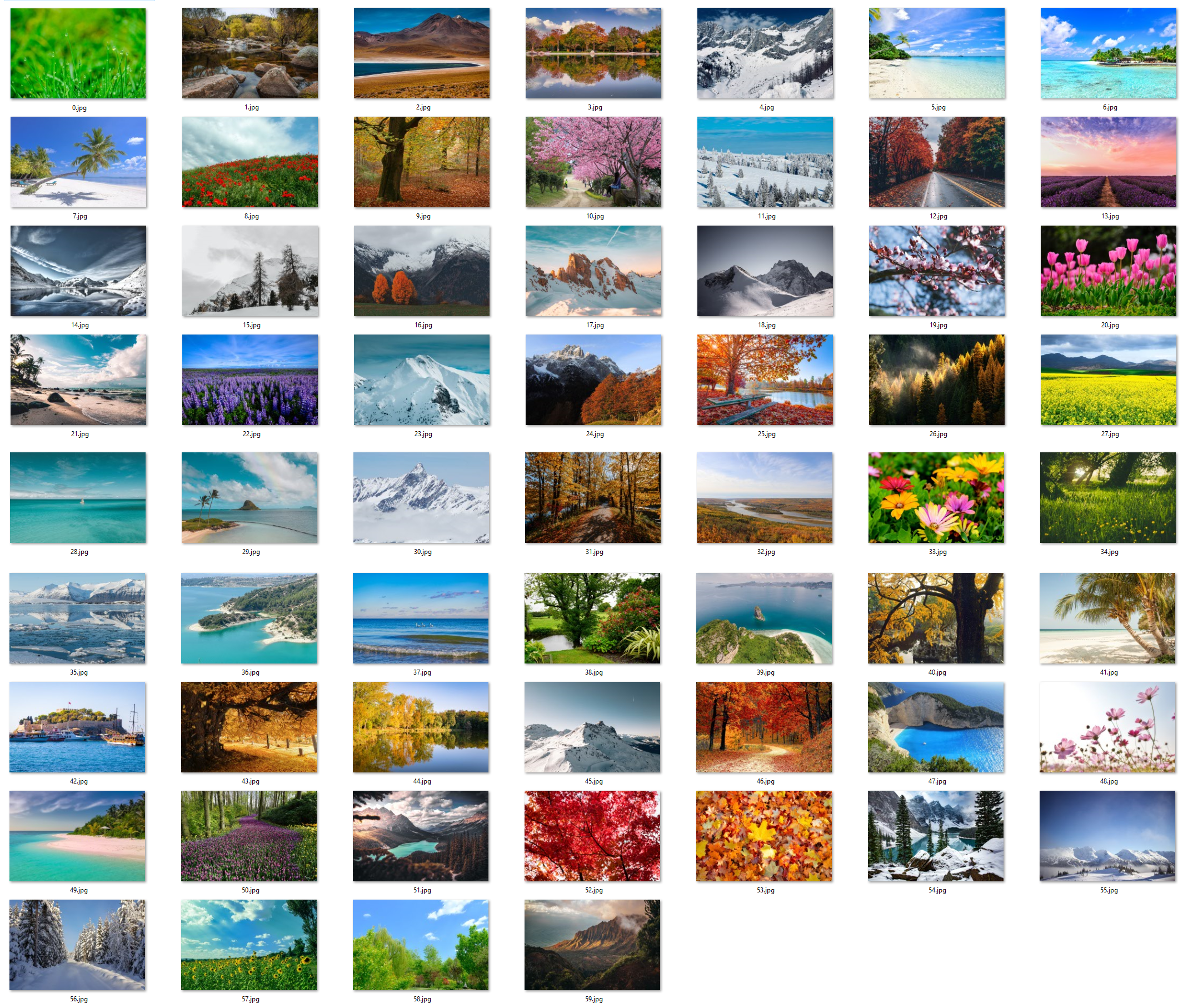
Fig. 22 Preview of the standard wallpapers provided by the vois library
In case there is the need for a custom background image, any valid URL string can be passed in the background_image parameter. To customize the appearance of the background image (for instance adding some blur, contrast, etc.), the background_filter parameter can be set with a string containing the CSS image filters to apply (example: ‘blur(2px) contrast(0.7)’). See https://developer.mozilla.org/en-US/docs/Web/CSS/filter for a list of available filters.
A similar example of a basic multi-page application can be found here: Multi Page Demo code
The corresponding running dashboard can be viewed here: Multi Page Demo
